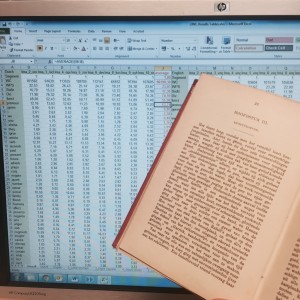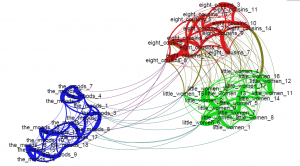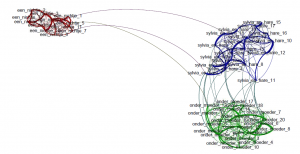In the last blog, I made use of several methods[i] from the discipline of literary studies to make sense of Louisa Alcott’s “journey”. In this blog, I want to cross disciplines and take a linguistic approach, working with several digital tools on the translations. Given that Huygens ING is a Digital Humanities (DH) institute and that the Travelling TexTs project is a DH project, with colleagues working in a Virtual Research Environment, it was quite obvious that I, too, would need to try using some DH tools. These tools connect with linguistics, approaching the textual material in different ways. Here I will present the results of my work with two different types of digital tools: stylometrics and ‘Linguistic Inquiry and Word Count’ (‘LIWC’ for short).
As far as stylometrics is concerned, I was motivated to try this approach by the projects of Prof. Jan Rybicki, a stylometrist from Cracow, who collaborates with Huygens ING. He happened to be in The Hague in February and was interested in my project, so we had the chance to ask for his expertise and make use of his analysis using ‘Stylo in R’. Such a stylometric approach is able to show the closeness between different texts, which can help drawing certain conclusions about the likely identity of the author or translator of a text, or their gender in case this is unknown. This digital tool makes use of the function words in a text to do so.
In the case of LIWC, it was Lennart van der Velden, a trainee in linguistics working in a Huygens ING project about another female author, who inspired me to use LIWC. [ii] LIWC was designed by the linguist James W. Pennebaker to count word frequencies; Pennebaker’s intention was to see if, with the help of a computer that can process large quantities of text, we could find out different things about texts than if we did an analysis entirely by human sight. For LIWC I chose to analyze the words in the original and the translation of Alcott’s texts, to see if we can notice any thematic changes. LIWC makes use of so-called dictionaries which include words surrounding a certain thematic area – it counts those words in these dictionaries that represent certain categories of word, thus mostly using content words for its analysis. [iii]
Computers & Books
In approaching the texts from a linguistic perspective, digital tools such as stylometric analysis and LIWC can help us answer questions concerning the textual material, in this case the translations and original texts of Alcott. What follows is an overview of my results so far— there is of course a lot of potential for future analysis and research that would go far beyond the limited scope of an internship.
My corpus of books was too small to provide a full stylometric analysis, but Prof Rybicki was still able to perform an analysis which gives us some insight into Alcott’s writing and and that of her translators. Using ‘Stylo in R’, he compared the frequencies of 100-1000 of the most frequent words in three of Alcott’s novels and their translations, which showed that 5000-word samples from the originals all group by book – but also that Little Women (1868) and Eight Cousins (1875) are similar to each other, whereas Moods (1882) stands apart (see figure 1). In terms of style Moods (1882) thus differs from the other two novels.[iv]
Figure 1: Graph ‘Closeness’ of Little Women (1868), Eight Cousins (1875) and Moods (1882) as analyzed in Stylo R
Figure 2: Graph ‘Closeness’ of Onder Moeder Vleugels (1876), Een Nichtje met Zeven Neven (1876) and Sylvia en Hare Luimen (1882) as analyzed in Stylo R
Figure 2 shows the analysis for the Dutch translations. Again, one novel stands out, but this time a different one: Een Nichtje met Zeven Neven (1876). This translation of Eight Cousins (1875) was supposedly done by P.J. Andriessen, who is a male translator, although it could also be the work of his younger daughter Suze Andriessen, herself a prolific translator at least between 1878 and 1885. In any case it is different from the other translations. By looking at the graph it becomes clear that the translations of Moods (1882 tr. unknown) and Little Women (1876 tr. female) are similar, with shared characteristics brought to the fore in this network analysis. This might indicate that they have the same translator, but we cannot say for sure.
With LIWC I did my own analysis, using all the original texts and translations. The following table presents a percentage of the total number of words of the text that related on average to each category, or in LIWC terms, ‘dictionary’. I included all those dictionaries that show a significant difference between the original and translation, or those related to topics discussed in the previous blog.[v]
Table 1: LIWC results word frequency in percentage on average for whole corpus of translations
| English | Dutch | |
| Cognitive Mechanisms | 16,49 | 16,90 |
| Affect | 7,35 | 5,46 |
| Positive Emotion | 5,29 | 3,59 |
| Negative Emotion | 1,98 | 1,76 |
| Swear Words | 0,04 | 0,00 |
| Home | 0,40 | 0,56 |
| Work | 1,02 | 0,67 |
What stands out most is how the use of cognitive mechanisms stays almost equal in translation, while affective words appear significantly less in the Dutch translations. In addition, while negative emotion seems to be just as present in the translation as in the original, positive emotions are less apparent in the translations. However small the difference in the use of swear words may be, it is striking to see that the translations did use no swear words at all, whereas the original contained at least a small number. And finally, when it comes to speaking about topics such as home and work the Dutch translations show a slightly higher percentage of words on home as a topic, but significantly less words about work than the original.
Dialogue between Disciplines
If we now compare the results of LIWC with my initial findings, as explained in my previous blog post, we can see how some interesting points emerge, which would perhaps not have been brought to the light in the same way without this interdisciplinary dialogue.
One of my first observations about the texts was that emotional content was left out and that pejorative translations were used for several emotional terms. In placing the LIWC analysis of emotional content in the Dutch context this might confirm our supposition about the existence of a ‘norm’ that instructs women to show less emotion. As a matter of fact, LIWC cannot tell us exactly which emotional content was left out, just that it was. However, because I have read the novels, I can contextualize these findings alongside my own comparison, which tells us that the emotional content left out relates mostly to the emotions of female characters. This dialogue between LIWC and my own findings as a close-reader leads, therefore, to the more general, though still provisional, conclusion that that this might have been a norm.
Regarding the educational value of the texts, we see a correlation emerging between LIWC and my initial findings concerning the dialogue between Alcott and some of her Dutch readers. While the texts were mostly praised by critics because of their “simplicity” (in both style and content), linked to, among other aspects, homely settings, the translations also show a slightly higher use of words referring to home in the LIWC analysis. By contrast, the use of words from the LIWC dictionary called ‘work’ is considerably lower in the Dutch translations. This dictionary contains words that are linked to education (as in both upbringing and professional education), and could therefore also be used in my case to illustrate the presence of education in the texts. This decrease is most present in Little Men (1871), which might be due to the passages about Nan’s education that were left out. This decrease of educational content contrasts with the reviews of Alcott’s work that consider them highly suitable for the education of girls and young women. However, the critics here praise a moral education for women in general, in contrast with Alcott’s writing on equal education for girls and boys. This is once again a telling indication of the norms regulating the role of women, especially concerning their education.
Bridging Disciplines
The dialogue I proposed between the different disciplines in the paragraph above can be placed in the context of transversal politics, which I use as a theoretical base in this series of blog posts. In “Trans/Feminist Methodology: Bridges to Interdisciplinary Thinking”[vi], a text which I first encountered at the start of my masters, Marjorie Pryse argues for a transdisciplinary approach elaborating the thoughts of Nira Yuval-Davis, an approach that has inspired my own bridging of several disciplines, to capture more data and different results. These disciplines build on each other, rather than operating separately.
Pryse builds on Yuval-Davis to develop a transdisciplinary approach, i.e. feminist interdisciplinary thinking that is based on “transversalism”. This sounds rather theoretical, but it is nothing more than a critical approach to gender studies (or women’s studies as she calls it) as a whole. Within gender studies, an interdisciplinary approach has become the standard, and the only common denominator is that everything within gender studies works on axes of difference such as gender, ethnicity and class. The problem is that this merely tries to combine different disciplines without presenting a method of its own. Instead, it builds on the assumption about certain identities within the research. Pryse wants to move away from this dynamics with the help of an approach based on transversalism, as proposed by Yuval-Davis. By continuing to engage with our own discipline, as well as by putting it into dialogue with other disciplines, we can, according to Pryse, come to a transdisciplinary approach which allows us to draw specific, as well as more general conclusions. By rooting and shifting between disciplines, in other words, we are able to develop a critical approach that takes into account different methodologies, and allows them to work together.
I started in literary studies, both in my academic career as well as in my analysis that I presented in the previous blog. These are my roots. To further my research, I put these results into dialogue with linguistic based approaches and digital tools, shifting my view to other discipline. Of course I am not a specialist in these fields, but they can help me to look at my questions from a different angle. This way of proceeding helped to uncover the journey of Alcott’s texts to the Netherlands thanks to complementary research outcomes. Norms on the roles of women, regarding their emotionality and education, can be researched in different sources. In the next blog I will look further into the question of what, in Alcott’s works, it means to be a woman, and what the expectations, the norms, that define what a woman is are. What difference is there between the US and the Netherlands and was Alcott, perhaps, ahead of her time?
[i] A close-reading comparison of translations and contextualization using receptions
[ii] See http://liwc.wpengine.com/ for this program.
[iii] LIWC can also make an analysis of function words, but I am leaving this out of consideration. But see https://www.youtube.com/watch?v=PGsQwAu3PzU for an inspiring TedX talk by Pennebaker on this subject.
[iv] This might be explained by the fact that this was her earliest novel, in a revised edition. See “A Place Among Its More Succesfull Sisters: Louisa May Alcott’s Wayward Moods” by Catherine S. Blackwell for a detailed study of this specific novel.
[v] For the Dutch dictionary I used the one developed by Peter Boot, Hanna Zijlstra and Rinie Geenen. Important to note is that there is of course a difference between the language and that I applied a more modern Dutch dictionary which does not account for certain differences in language.
[vi] See: Marjorie Pryse, “Trans/Feminist Methodology: Bridges to Interdisciplinary Thinking”, in: Feminist Formations, Vol. 12, No. 2, 2000, pp. 105-118.


